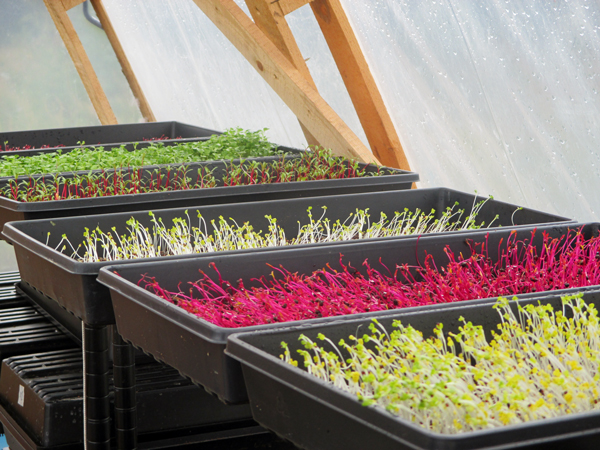The average farmer in the U.S. is nearly 60-years-old. Three young and idealistic Alaskans are defying that trend with a new farm near Talkeetna. Bare Hands organic Farm is only one acre, but its owners have big plans.
Bare Hands farm, like much of the Upper Valley’s farm land, is a little out of the way. After leaving the Talkeetna Spur Road and driving a few miles over gravel, then through a series of private driveways, I made it there while only getting lost once. I was met by two of the three people who operate the farm.
KNAPP: “I’m Graham Knapp.”
SYKES: “I’m Mindy Sykes.”
The third partner in Bare Hands Farm is John Sargent, who works in Bethel, but is planning on spending more time on the farm in future seasons. In a time when the federal government says the average age of a farmer is fifty-seven, the trio represent an infusion of youth to the agriculture industry.
Graham Knapp says that he sees what Bare Hands Farm is doing as part of a larger trend within his generation.
“I think there is a movement out there with young people who want to diversify a little bit and create farms that are more community oriented, and where you typically wouldn’t find other small farms. They just want to infuse the community with fresh, local food.”
Mindy Sykes’ reasons for getting involved in small-scale farming are rather similar to what Graham describes.
“For me, it’s probably just my love for food, and good food, and becoming more aware of how my food was grown and not wanting to partake of that, and choosing to take part in how food, in my opinion, can be and should be grown.”
While Bare Hands Farm does produce a variety of vegetables, including zucchini, turnips, and leafy greens, one of the ways that the owners have found to break into the market is by thinking small, as I discover when we walk into the greenhouse.
“Primarily, we’ve been using this for our micro-greens operation.”
Micro-greens are basically exactly what they sound like, as Graham Knapp explains.
“When a plant first comes up, it’s got it first two leaves, called the cotyledons, and when the first true leaves come in you can harvest them, and that’s considered micro-greens.”
The micro-greens are grown from a number of edible plants, and it’s possible to substitute them as ingredients in a salad, but that takes a lot of them, so Graham says that restaurants like to use them as a garnish or to add an edible visual element to a meal.
“We like to add color and find the ones that have some color to it, and we find the restaurants like that as an aesthetic quality to their plates.”
Bare Hands Farm currently sells to two local restaurants, Twister Creek and the Talkeetna Alaskan Lodge. Mindy Sykes says that there has been interest from other businesses, but the growing capacity will have to expand in order to take on additional customers.
“Other restaurants are interested in buying our micro-greens and using them as well, but the brewery and the lodge, with our little greenhouse, was enough for us. In the future, with our larger greenhouse and dialing it in a little more, we’d love to be able to provide that to more people.”
After looking at the greenhouse, Graham and Mindy took me to the vegetable rows, where they have a mix of leafy greens, root vegetables, and even one pumpkin that produced fruit. Graham Knapp says that selling the vegetables to restaurants is something that might happen in the future, but it’s not the primary goal right now.
“Our main goal is to feed the residents of Talkeetna, and anything on top of that is good too.”
For now, feeding Talkeetnans largely means selling at a local farmers market during the summer. While expansion is definitely being considered, Graham Knapp says that
it doesn’t necessarily take a lot of land to get a large yield.
“It’s amazing how much food you can grow in a small area. We’re putting out a lot of food on under an acre. We tossed around some numbers. How big to we want to get? Two, or three, or five acres? But that is so much food when you’re growing right.”
One of the biggest challenges that faces Alaskan farmers is the short growing season. Graham Knapp says he wants to try different methods for extending that season to provide vegetables later in the year.
“I really want to experiment with growing into the fall a little more with the high tunnels we have coming in, and starting things really early, and really extending the seasons a lot more.”
My tour of Bare Hands Farm ended at the chicken enclosure, where more than two dozen birds were hiding from the drizzle that had begun. Some of the birds have recently begun laying eggs, and many more will start soon. Graham and Mindy are also raising chickens for meat, both for nutritional and ethical reasons.
KNAPP: “Mindy and I have kind of sworn off industrial meat, because we know it’s not treated very well…”
SYKES: “And it’s not good for you. The omega-three to sixes are off, because they’re eating food they’re not supposed to be eating, so it’s really not the best.”
KNAPP: “Yep. We like to know that any meat that’s going to be consumed by us had a good life, ate well, lived well, and was well taken care of.”
As I got into my truck and drove away, Graham Knapp and Mindy Sykes went immediately back to work, making the most of what’s left of the Alaskan summer at Bare Hands Farm.
– See more at: http://ktna.org/2014/08/26/upper-valley-agriculture-bare-hands-farm/#sthash.IhfYLiy3.dpuf





